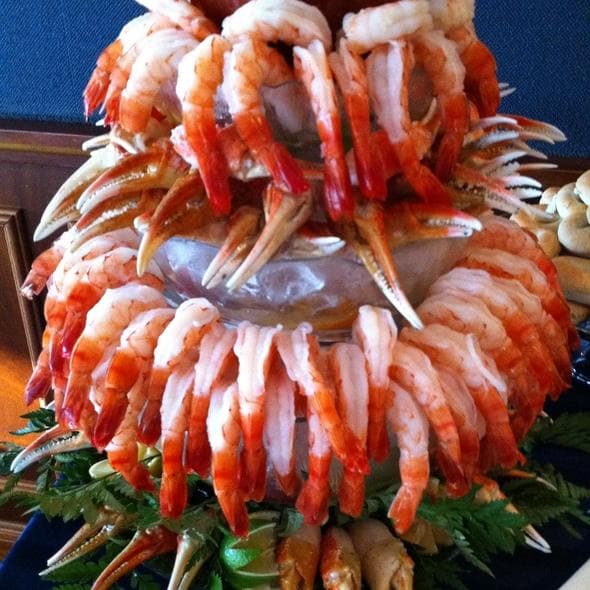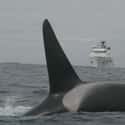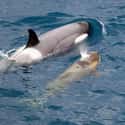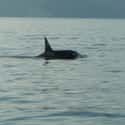-
(#1) Orcas Have Complex Hunting Practices
With the word “killer” in the name, it’s safe to assume that the killer whale is a skilled marine hunter. Orcas hunt in pods, a family group which has been known to number as many as 40 individuals. Pods can be permanent or temporary, and depending on which they are, may hunt different prey and employ different hunting techniques.
When hunting seals, who rest on ice floats, orcas have been known to create massive waves to knock their prey off before attacking. For sharks, the whales crash down on the shark's head and flip them over, forcing sharks into something scientists call “tonic immobility.” Basically, it's a 15-minute state of paralysis, during which the orca suffocates and kills the shark. This displays an incredible knowledge of shark biology.
For schools of fish, instead of chasing down individuals, killer whales will create a net of air bubbles and belly flashes to herd them into a tight ball before feeding. They even attack whales much larger than themselves, killing gray, humpback, and even blue whales. Orcas force themselves on top of the much larger, less agile, whale and keep them from breaching, preventing the larger whale from breathing. Finally, when hunting sea lions and elephant seals, orcas will literally storm beaches, launching themselves onto the sand and snatching their prey before dragging them into the deadly depths of the ocean.
-
(#2) A Mother's Pregnancy Lasts 17 Months
A female killer whale will reproduce every three to ten years with only one calf at a time. The gestation period is an astounding 17 months, and when born, a calf will be about 8.5 feet in length and weigh only 265 to 350 pounds. Calves nurse for 5 to 10 seconds at a time, several times an hour throughout the day. They are weaned off milk at around one years old, when they are strong enough to hunt and feed with the rest of the pod.
Orcas are incredibly protective of their young and other females in the pod will often assist a new mother in caring for her young.
-
(#3) Pods Of Whales Have Different Dialects Of Communication
Much like other pack animals and animals of high intelligence, orcas depend on a complex and diverse communication system. Much like their dolphin relatives, orcas use a series of clicks, whistles, and chirps to cut through the water and communicate with one another. Orcas are able to create these sounds with the use of a compact tissue in the nasal cavity and hear them with their nearly invisible, highly developed ears located behind their eyes.
Scientists continue to study the sounds that killer whales make, and while much is still unknown, they have discovered that all pods create completely different sets of sounds from other pods. When orcas are born, they are able to employ a very rudimentary repertoire of sounds, and learn their pod’s “dialect” over time. This use of language and its variance across pods from all over the world proves just how intelligent these marine mammals are.
In fact, the differences in prey preference, hunting practice, and communication has lead some scientists to believe that orcas are the only non-human mammal whose evolution is driven by culture, as opposed to natural selection.
-
(#4) They Are The Largest Dolphin
While the world ‘whale’ is in the orca’s colloquial name, “Killer Whale,” the orca is in fact the world’s largest species in the dolphin family. Orcas are massive animals, weighing up to 6 tons and growing from 23 to 32 feet in length. This compares to the common bottlenose dolphin, which are between 10 to 14 feet long and weigh approximately 1,100 pounds. While a dolphin's size is relative to that of a large human, the orca's size is relative to that of a bus.
In addition to their big size, killer whales are also known for their large dorsal fin which can reach up to 6 feet.
-

(#5) Controversy Concerning Captivity Of Orcas Sparked Massive Public Outrage
Thanks to the 2013 documentary Blackfish, the truth behind orca captivity has become widespread knowledge. According to the documentary, at the time of filming, there were 61 orcas held in captivity, with only 33 being captive-born. The other 28 were captured in the wild. Of the 156 orcas that have been taken into captivity from the wild since 1961, 128 have died, not including 30 miscarried or still-born calves.
On top of the deaths of orcas, killer whale captivity has been responsible for 4 human deaths. Since Blackfish, many have come out against SeaWorld and similar marine life parks, likening captivity for the massive, intelligent mammals to prison and torture.
-
(#6) Life Expectancy Is Shockingly Different For Killer Whales In Captivity
Of the whales that have lived in captivity, 92% have not made it past the age of 25, despite the fact that the average male in the wild lives to 30 and the average female lives to 50. Some even live up to 90 years old! This uncanny, short life-span for whales in captivity is likely due to their tiny tanks, lack of hygiene, absence of a social structure, and inability to travel freely across long distances as they would be able to in the ocean.
Life expectancy isn’t the only physical change found in captive whales. A shocking 100% of captive whales experience what scientists now call dorsal fin collapse, which occurs because they spend too much time on the surface of their shallow tanks, allowing gravity to have an impact on their graceful dorsal fin.
-

(#7) Killer Whales Are Seen As Symbols Of Power In Native American Culture
Orca are a common image on the iconic totem poles native to the Northwest coast of North America. Given its prowess in combat and its sheer size, the orca is a powerful symbol for different Native American groups.
The Tlingit view killer whales as a symbol of power and strength, and believe that sighting one is considered a momentous omen. Though they hunted other kinds of whales, the Tlingit saw the killer whale as a special protector of humankind and never hunted the giant black-and-white mammals.
The Kwakiutl tribes believed that the souls of ocean hunters turned into killer whales upon their death, just as the souls of forest hunters turned into wolves. For this reason, there were many special rituals regarding the killing of a killer whale, so that its spirit could be reborn as a human once again.
-
(#8) Orcas Have Giant Teeth That Can Tear Apart Skin And Bone
Not only are orcas incredibly skilled hunters, but they're also adept killers. Orcas have massive three-inch teeth that line their jaws. These cone-shaped teeth number between 40 and 56, depending on the size of the whale. These teeth are not only useful to hold their prey in their mouth and tear at their flesh, but are so sharp that they can cut through thick skin, blubber, and bone. Whales do not chew their prey, but instead eat it in massive, bloody chunks.
-
(#9) In Terms Of Habitat, Orcas Are Spread Out All Over The Globe
Thanks to their ability to hunt nearly any other animal in the ocean, killer whales are the most widely distributed mammals aside from humans. Orcas are known to live in the warm waters near the equator and the frigid regions near the North and South pole.
More often than not, orca pods live close to the shore since that's where the majority of sea lions gather. Depending on where the whales are found and what they feed on, killer whales have been split into four groups that have been considered different “races,” or sub-species. These differences include special diets, habitats, size, weight, coloration, and eye patch size.
-
(#10) Animal Coloration
- Book
The killer whale is certainly one of the most recognizable animals in the ocean, thanks to their sleek, black body and beautiful white spot above their eyes. But why the coloration, and why do the white eyespots exist? Scientists believe that the eyespot is a way for orcas to confuse their prey, as they do not know where their real, smaller eye is. Additionally, the black coloration hides them in the depths below, as orcas use the dark ocean water as a form of camouflage while pursuing their prey.
-
(#11) Orcas Are Scary Fast In Water
Orcas are among the fastest swimming marine mammals in the world. While they can cruise consistently at a speed of about eight miles per hour, they can reach a blistering 28 miles per hour when pursuing prey. Killer whales are also highly maneuverable and can change direction underwater quickly to continue pursuit of their much smaller prey.
-
(#12) Orcas Are At Risk Of Endangerment
While orcas are thought to be the most widespread mammal worldwide (after humans), they're still at risk of endangerment. An exact count as to the numbers of their population is difficult to ascertain, since pods are known to move through wide ranges of ocean. However, it's clear what's killing them: prey depletion. As bio-contamination, overfishing, increased ship traffic, and habitat loss continues, orcas run into the risk that there will not be enough prey to support their population.
Another factor that contributes to endangerment is the whaling industry that still exists in parts of Greenland, Japan, Indonesia, and some of the Caribbean islands. Additionally, targeted live captures, such as the ones that have taken place on behalf of SeaWorld and marine parks in Russia, have greatly impacted the Pacific Northwest and North Atlantic populations. They were heavily targeted and have yet to reach pre-capture numbers.
If you are concerned with the plight of the orca, you can “adopt” an orca through the WDC.
New Random Displays Display All By Ranking
About This Tool
Killer whales are the largest species in the dolphin family. They are fierce carnivores, good at hunting prey, and are natural enemies of animals such as penguins and seals. Sometimes they even attack other cetaceans, even great white sharks, which can be called the kings of the sea. Killer whales are distributed in almost all ocean areas and have almost no natural enemies.
Despite the increasing use of the name "orcas", the traditional name "killer whale" is most commonly used by English-speaking scientists. The random tool describes 12 fascinating facts about killer whales that prove they are the most brilliant hunters in the ocean.
Our data comes from Ranker, If you want to participate in the ranking of items displayed on this page, please click here.




















